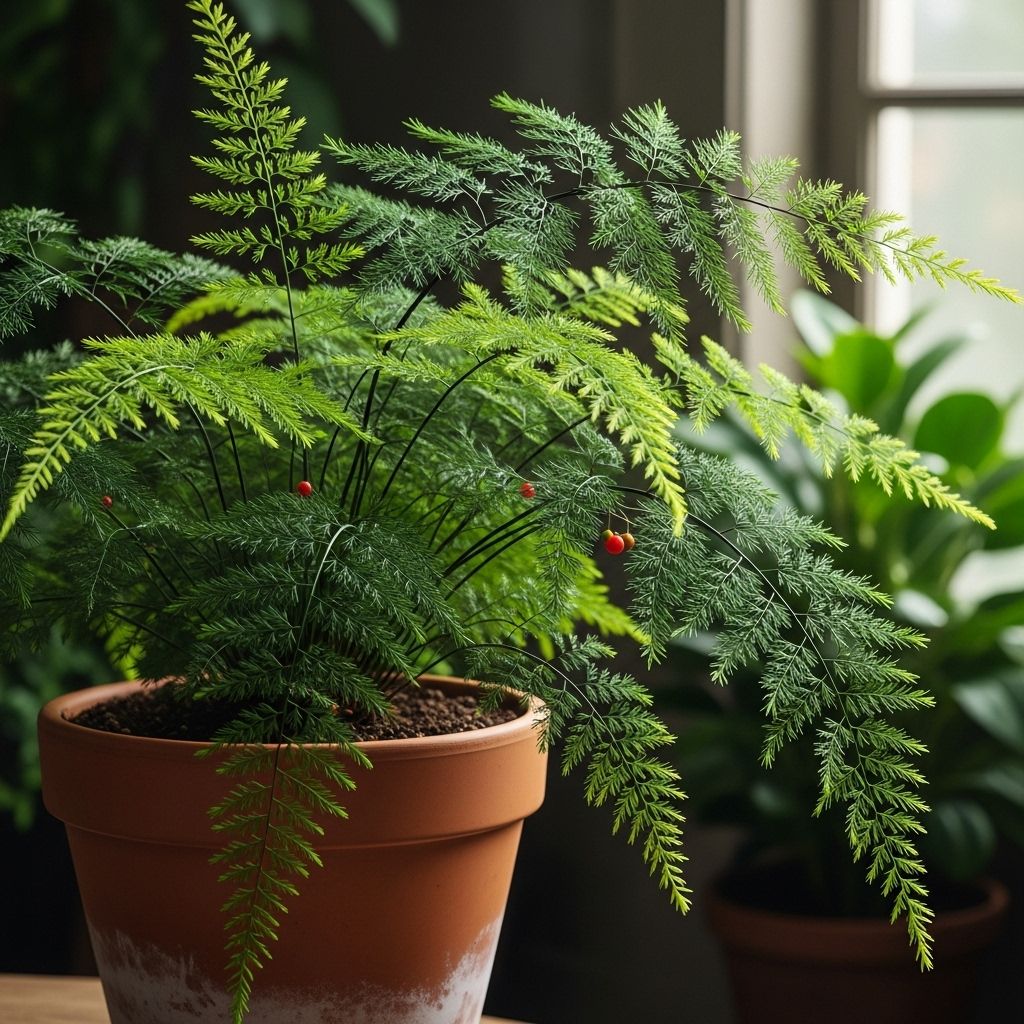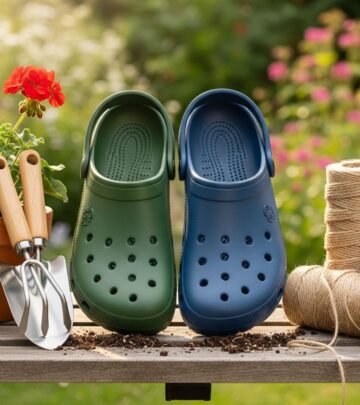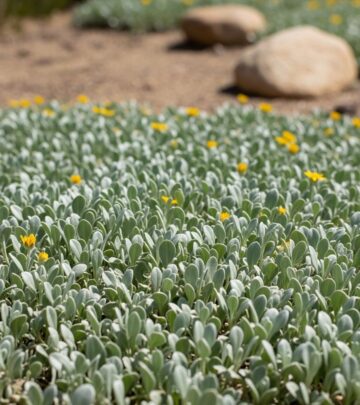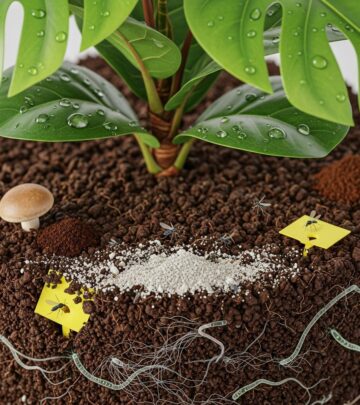Asparagus Fern Care: Complete Guide For Lush, Thriving Greens
Master the art of nurturing this delicate-looking yet resilient houseplant with our comprehensive care guide

Image: HearthJunction Design Team
Introduction to the Asparagus Fern
Despite its name, the Asparagus Fern (Asparagus setaceus) isn’t actually a fern at all. This delicate-looking houseplant belongs to the Asparagaceae family and is native to South Africa. With its feathery, lace-like foliage that cascades elegantly, it has become a popular choice for indoor gardeners seeking to add texture and a touch of softness to their plant collection. The Asparagus Fern creates an illusion of delicacy, but don’t be fooled—this is actually a resilient and adaptable plant that can thrive for years with proper care.
The Asparagus Fern features numerous tiny branches that create a fluffy, full appearance. These branches are covered with tiny, needle-like structures that aren’t actually leaves but modified stems called cladodes. The plant’s true leaves are actually the small, barely noticeable scales at the base of these cladodes. This unique structure gives the Asparagus Fern its distinctive, cloud-like appearance that has made it a beloved decorative houseplant for generations.
Varieties of Asparagus Fern
Several varieties of Asparagus Fern are popular among houseplant enthusiasts, each with unique characteristics:
Asparagus Setaceus (Plumosa Fern)
This is the most common variety, featuring delicate, feathery fronds that create a fluffy, cloud-like appearance. Its bright green foliage grows in a spreading habit, making it perfect for hanging baskets or as a trailing plant on shelves.
Asparagus Densiflorus ‘Sprengeri’
Often called Sprenger’s Asparagus, this variety has a more cascading habit with arching stems covered in needle-like leaves. It produces small white flowers followed by bright red berries, adding visual interest to the already attractive foliage.
Asparagus Densiflorus ‘Myers’ (Foxtail Fern)
With its upright, bottle-brush-like fronds, the Foxtail Fern creates a dramatic architectural statement. Its densely packed, cylindrical stems resemble a fox’s tail, hence the common name. This variety is particularly striking as a standalone specimen plant.
Asparagus Scandens (Climbing Asparagus)
This variety features a more delicate appearance with finer foliage and a climbing habit. It’s excellent for training up trellises or allowing to cascade from hanging planters.
Essential Asparagus Fern Care Guide
Light Requirements
Asparagus Ferns thrive in bright, indirect light conditions. They can adapt to medium light levels but avoid placing them in direct, harsh sunlight as this can scorch their delicate fronds. An east or west-facing window provides ideal lighting conditions, allowing the plant to receive gentle morning or evening sun. If natural light is limited in your space, consider supplementing with artificial grow lights to ensure your Asparagus Fern maintains its vibrant color and lush growth.
Soil and Potting
The key to success with an Asparagus Fern is fast-draining soil that provides adequate aeration for the roots. A loose, airy potting mixture is essential for preventing root rot and other moisture-related issues. You can create an ideal growing medium by mixing equal parts of regular potting soil and perlite to improve drainage and aeration.
Alternatively, a loamy soil mixture consisting of 20% clay, 40% sand, and 40% silt works excellently for Asparagus Ferns. This composition mimics their natural growing conditions and provides the perfect balance of moisture retention and drainage. When selecting a container, choose one with ample drainage holes to prevent water from pooling at the bottom.
Watering Routine
Asparagus Ferns prefer consistent moisture but are susceptible to root rot if overwatered. The goal is to keep the soil lightly moist but never soggy. Always check the soil before watering by inserting your finger about an inch deep into the soil—if it feels dry at this depth, it’s time to water. During the growing season (spring and summer), you’ll likely need to water more frequently than during the dormant winter months.
When watering, thoroughly saturate the soil until water drains from the bottom of the pot, then discard any excess water from the saucer. This approach ensures the roots receive adequate hydration while preventing the plant from sitting in standing water. Depending on your home’s conditions, you might need to water your Asparagus Fern once or twice a week during active growth and less frequently during winter.
Temperature and Humidity
Asparagus Ferns grow best in temperatures between 12-25°C (55-75°F), making them well-suited to average household conditions. They can tolerate brief periods outside this range but will show signs of stress with prolonged exposure to extreme temperatures. Keep these plants away from cold drafts, air conditioning vents, and heating sources that can cause rapid temperature fluctuations.
While Asparagus Ferns can adapt to average household humidity levels (around 40-50%), they truly thrive in slightly more humid environments. If your home is particularly dry, especially during winter months with heating systems running, consider increasing humidity around your plant. This can be accomplished through regular misting, placing the pot on a pebble tray with water, or using a small humidifier nearby.
Fertilizing Schedule
During the growing season (spring through early fall), feed your Asparagus Fern with a balanced, water-soluble houseplant fertilizer diluted to half the recommended strength. Apply this fertilizer once a month to provide essential nutrients without the risk of fertilizer burn. In winter, when growth naturally slows, reduce feeding to once every two months or stop altogether until spring returns.
Asparagus Ferns particularly benefit from fertilizers containing micronutrients like iron, which help maintain their vibrant green color. If you notice pale or yellowing fronds despite adequate light conditions, your plant might benefit from an iron supplement specifically formulated for houseplants.
Pruning and Maintenance
Regular pruning helps maintain the attractive, bushy appearance of Asparagus Ferns and prevents them from becoming leggy or sparse. Using clean, sharp scissors or pruning shears, trim back any yellowing, damaged, or dead fronds at the base. Don’t be afraid to prune quite aggressively if needed—Asparagus Ferns respond well to trimming and will often grow back fuller and more lush.
For maintenance purposes, gently dust the delicate fronds periodically using a soft brush or by giving the plant a gentle shower under lukewarm water. This prevents dust buildup that can impede photosynthesis and diminish the plant’s ornamental value. Be sure to allow the plant to drain thoroughly after showering to prevent water from accumulating in the crown.
Propagation Methods
Division
The most reliable method for propagating Asparagus Ferns is through division. This is best done during repotting in spring. Carefully remove the plant from its pot and gently separate the root ball into smaller sections, ensuring each division has a good portion of roots and several healthy stems. Plant each division in its own pot with fresh potting mix, water thoroughly, and place in bright, indirect light. The new plants may take a few weeks to establish but will soon begin producing new growth.
Seed Propagation
Asparagus Ferns occasionally produce small white flowers that develop into bright red berries containing seeds. These can be harvested when fully ripe and used for propagation, though this method takes considerably longer than division. Sow the seeds in moist potting mix, cover lightly, and keep warm and consistently moist until germination occurs, which can take several weeks. Seedlings develop slowly and may not resemble the parent plant for many months.
Repotting Your Asparagus Fern
Asparagus Ferns typically need repotting every 2-3 years as they grow and develop an extensive root system. Signs that your plant needs repotting include roots emerging from drainage holes, water running straight through the pot without being absorbed, or slowed growth despite proper care. The best time to repot is in spring as the plant enters its active growing season.
When repotting, choose a container that’s only 1-2 inches larger in diameter than the current pot. Excessive pot size can lead to overwatering issues as the soil stays wet for too long. Use fresh potting mix and ensure the plant is positioned at the same depth as before. After repotting, water thoroughly but then allow the soil to dry slightly before the next watering to help the plant adjust to its new home.
Common Problems and Troubleshooting
Yellowing Fronds
Yellowing fronds often indicate either overwatering or underwatering. Check the soil moisture and adjust your watering schedule accordingly. Consistently soggy soil leads to root rot, while overly dry conditions stress the plant. Yellow fronds can also result from insufficient light or nutrient deficiencies. If your watering routine is appropriate, try moving the plant to a brighter location or applying a balanced fertilizer.
Brown Tips
Brown tips on the fronds typically suggest low humidity or excessive fertilizer. Increase humidity around the plant through misting or a pebble tray, and ensure you’re not over-fertilizing. Flush the soil thoroughly with water if you suspect fertilizer buildup. Brown tips can also result from chlorine or fluoride in tap water—consider using filtered or distilled water if this is an issue in your area.
Pest Management
Asparagus Ferns can occasionally attract pests such as spider mites, mealybugs, and scale insects. Spider mites are particularly problematic during dry conditions and can be identified by fine webbing between fronds and a stippled appearance on the foliage. Regular inspection of your plant helps catch infestations early. For minor issues, wiping the stems with a damp cloth or spraying with insecticidal soap can be effective. For more serious infestations, consider using neem oil or a commercial houseplant insecticide following the manufacturer’s instructions.
Frequently Asked Questions
Q: Is Asparagus Fern toxic to pets?
A: Yes, Asparagus Ferns are toxic to cats and dogs if ingested. The berries are particularly dangerous. Symptoms of poisoning include gastrointestinal upset, dermatitis, and allergic reactions. Keep these plants out of reach of curious pets.
Q: Why are my Asparagus Fern’s fronds dropping needles?
A: Needle drop often indicates environmental stress, typically from inconsistent watering, sudden temperature changes, or very low humidity. Ensure your plant receives consistent care and stable conditions. Some seasonal needle drop is normal, but excessive shedding requires attention to the plant’s environment.
Q: Can Asparagus Ferns be grown outdoors?
A: Asparagus Ferns can be grown outdoors in USDA hardiness zones 9-11 as perennials. In cooler climates, they’re often used as annual bedding plants or in containers that can be brought indoors before frost. When grown outdoors in suitable climates, they can become quite large and even invasive in some regions.
Q: How fast do Asparagus Ferns grow?
A: With proper care, Asparagus Ferns are moderately fast growers. Under ideal conditions, they can fill out a pot within a single growing season. Growth slows considerably during winter months and accelerates in spring and summer when light levels increase and temperatures warm.
Q: Do Asparagus Ferns clean the air?
A: Like many houseplants, Asparagus Ferns do contribute to improved air quality by absorbing carbon dioxide and releasing oxygen through photosynthesis. However, they aren’t among the most efficient air-purifying plants. Their primary value is ornamental rather than air-purifying.
Decorative Uses and Styling Tips
The Asparagus Fern’s delicate, feathery appearance makes it an excellent choice for various decorative applications. Its cascading habit works beautifully in hanging baskets where the fronds can spill over the sides, creating a soft, waterfall effect. On shelves or plant stands, they add texture and movement to plant displays, complementing plants with broader, more structured leaves.
In terrariums or dish gardens, smaller Asparagus Fern specimens provide a lush background for other miniature plants. Their fine texture creates depth and interest without overwhelming the composition. For a dramatic statement, consider featuring a mature Foxtail Fern variety as a standalone specimen in an attractive container that complements your décor style.
With proper care and attention to its specific needs, your Asparagus Fern will reward you with years of lush, graceful growth that enhances any indoor space with its distinctive texture and form.
References
- https://bloomscape.com/plant-care-guide/asparagus-fern/
- https://thegreenmadhouse.com/plants/beginners-guide-to-the-asparagus-fern
- https://www.thespruce.com/grow-asparagus-ferns-1902714
- https://houseplanthouse.com/2021/09/12/asparagus-fern-care-guide/
- https://plnts.com/en/care/houseplants-family/asparagus
Read full bio of Anjali Sayee












